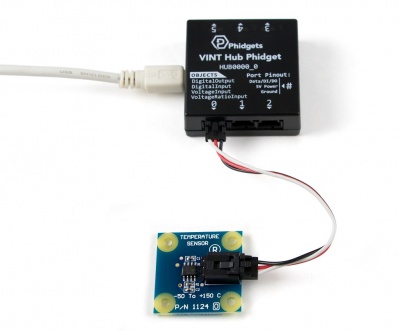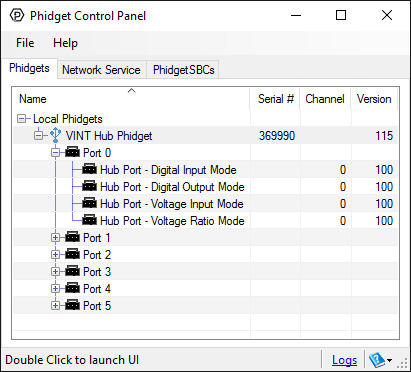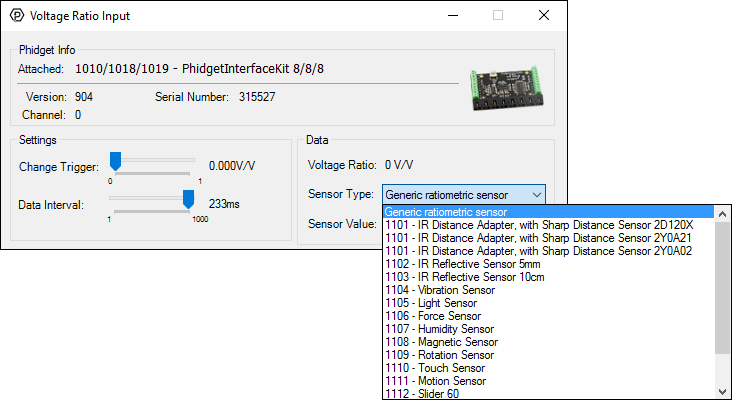1124 User Guide: Difference between revisions
(Created page with "==Getting Started== ===Checking the Contents=== {{UGbox| '''You should have received:''' * A precision temperature sensor * A sensor cable | '''In order to test your new Phi...") |
|||
| (21 intermediate revisions by 4 users not shown) | |||
| Line 1: | Line 1: | ||
__NOINDEX__ | |||
<metadesc>The Phidgets Temperature Sensor measures the ambient air temperature surrounding the board. Connects to an Analog Input or VINT Hub port.</metadesc> | |||
[[Category:UserGuide]] | |||
==Getting Started== | ==Getting Started== | ||
{{UgSensorIntro|1124|Precision Temperature Sensor|Voltage Ratio Input port}} | |||
Next, you will need to connect the pieces: | |||
[[Image:1124_0_Connecting_The_Hardware.jpg|400px|right|link=]] | |||
#Connect the | # Connect the 1124 to the HUB0000 with the Phidget cable. | ||
#Connect the | # Connect the HUB0000 to your computer with the USB cable. | ||
= | <br clear="all"> | ||
{{UGIntroDone|1124}} | |||
{{ | ==Using the 1124== | ||
{{UGcontrolpanelSensor|1124|HUB0000}} | |||
{{UGSensorVoltageRatioInput|1124|temperature (°C)}} | |||
==Technical Details== | |||
===Higher Range Measurements=== | |||
If you don't use setSensorType() and simply convert from voltage to degrees using the formula below, you can measure temperatures up to 150°C. However, the components on the 1124 are rated for a maximum of 80°C, so this should only be done for short periods for testing purposes. | |||
===Formulas=== | ===Formulas=== | ||
The Formula to translate | {{UGSensorFormula|temperature (°C)}} The Formula to translate voltage ratio from the sensor into temperature is: | ||
{{ | ::<math> | ||
\text{Temperature (}^\circ \text{C)} = \text{(VoltageRatio} \times \text{222.2) - 61.111} | |||
</math> | |||
<br clear="all"> | |||
{{UGasens}} | {{UGasens}} | ||
{{UGnext|}} | |||
{{ | |||
Latest revision as of 15:46, 4 August 2021
Getting Started
Welcome to the 1124 user guide! In order to get started, make sure you have the following hardware on hand:
- 1124 - Precision Temperature Sensor
- Any Phidget with a Voltage Ratio Input port, here are some compatible products. We will be using the VINT Hub for this guide.
- USB cable and computer
- Phidget cable
Next, you will need to connect the pieces:

- Connect the 1124 to the HUB0000 with the Phidget cable.
- Connect the HUB0000 to your computer with the USB cable.
Now that you have everything together, let's start using the 1124!
Using the 1124
Phidget Control Panel
In order to demonstrate the functionality of the 1124, we will connect it to the HUB0000, and then run an example using the Phidget Control Panel on a Windows machine.
The Phidget Control Panel is available for use on both macOS and Windows machines. If you would like to follow along, first take a look at the getting started guide for your operating system:
Linux users can follow the getting started with Linux guide and continue reading here for more information about the 1124.
First Look
After plugging in the 1124 into the HUB0000, and the HUB0000 into your computer, open the Phidget Control Panel. You will see something like this:

The Phidget Control Panel will list all connected Phidgets and associated objects, as well as the following information:
- Serial number: allows you to differentiate between similar Phidgets.
- Channel: allows you to differentiate between similar objects on a Phidget.
- Version number: corresponds to the firmware version your Phidget is running. If your Phidget is listed in red, your firmware is out of date. Update the firmware by double-clicking the entry.
The Phidget Control Panel can also be used to test your device. Double-clicking on an object will open an example.
Voltage Ratio Input
Double-click on a Voltage Ratio Input object in order to run the example:

General information about the selected object will be displayed at the top of the window. You can also experiment with the following functionality:
- Modify the change trigger and/or data interval value by dragging the sliders. For more information on these settings, see the data interval/change trigger page.
- Select the 1124 from the Sensor Type drop-down menu. The example will now convert the voltage into temperature (°C) automatically. Converting the voltage to temperature (°C) is not specific to this example, it is handled by the Phidget libraries, with functions you have access to when you begin developing!
Technical Details
Higher Range Measurements
If you don't use setSensorType() and simply convert from voltage to degrees using the formula below, you can measure temperatures up to 150°C. However, the components on the 1124 are rated for a maximum of 80°C, so this should only be done for short periods for testing purposes.
Formulas
The Phidget libraries can automatically convert sensor voltage into temperature (°C) by selecting the appropriate SensorType. See the Phidget22 API for more details. The Formula to translate voltage ratio from the sensor into temperature is:
Phidget Cable

The Phidget Cable is a 3-pin, 0.100 inch pitch locking connector. Pictured here is a plug with the connections labelled. The connectors are commonly available - refer to the Analog Input Primer for manufacturer part numbers.
What to do Next
- Programming Languages - Find your preferred programming language here and learn how to write your own code with Phidgets!
- Phidget Programming Basics - Once you have set up Phidgets to work with your programming environment, we recommend you read our page on to learn the fundamentals of programming with Phidgets.

